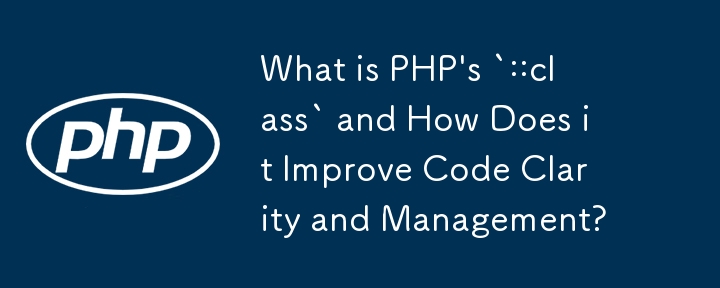Found a total of 10000 related content

What is the use of the << operator in PHP?
Article Introduction:In PHP, implementing polymorphism can be achieved through method rewriting, interfaces, and type prompts. 1) Method rewriting: Subclasses override parent class methods and perform different behaviors according to object type. 2) Interface: The class implements multiple interfaces to realize polymorphism. 3) Type prompt: Ensure that the function parameters are specific to the type and achieve polymorphism.
2025-05-20
comment 0
1135

How to align a form in Bootstrap
Article Introduction:Use the default block layout to create a vertical form, each control occupies one row, and add spacing through the mb-3 class; 2. Use the .row and .col-* classes to arrange the labels and input boxes side by side to realize horizontal form layout, and align the submit buttons with offset-sm-2; 3. Use elastic box tool classes such as d-flex to create inline forms, and optimize the layout with the me-2 equal spacing class; 4. Center the form by wrapping the form in the d-flexjustify-content-center container and setting max-width. Bootstrap5 easily implements various form alignments by combining grids and tool classes.
2025-08-23
comment 0
489

Explain late static binding in PHP (static::).
Article Introduction:Static binding (static::) implements late static binding (LSB) in PHP, allowing calling classes to be referenced in static contexts rather than defining classes. 1) The parsing process is performed at runtime, 2) Look up the call class in the inheritance relationship, 3) It may bring performance overhead.
2025-04-03
comment 0
604
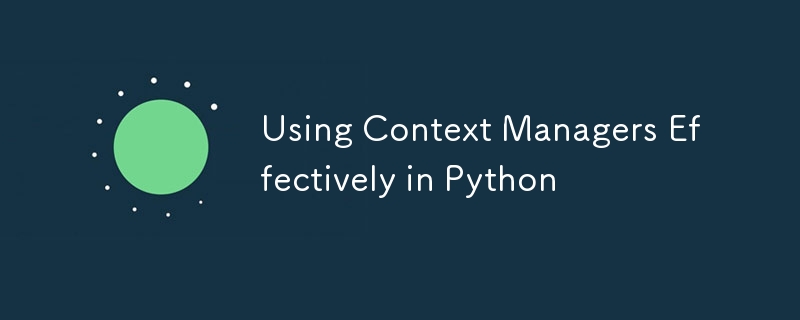
Using Context Managers Effectively in Python
Article Introduction:ContextManager is a tool used in Python to automatically manage resources, ensuring the correct release of resources through with statements; its core is a class that implements enter and exit methods or a generator function that uses contextmanager decorator; common application scenarios include file operations, database connections, locking mechanisms and temporary directory management; when customizing, you need to pay attention to exception handling, cleaning logic and resource nesting management.
2025-07-22
comment 0
947
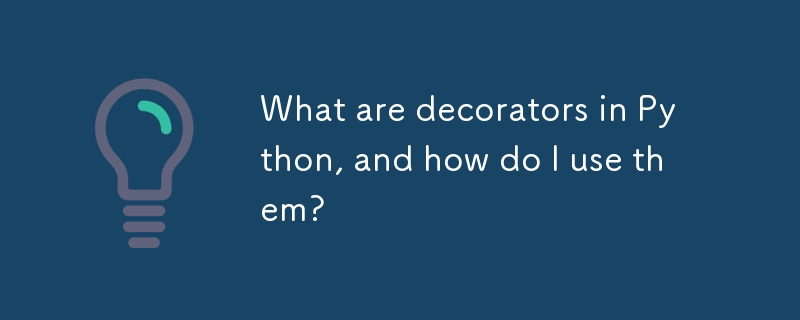
What are decorators in Python, and how do I use them?
Article Introduction:A decorator is a tool that modifies or enhances the behavior of a function or class without changing its source code. It implements function extension by accepting the objective function or class as parameters and returning a new wrapped function or class. It is often used to add logs, permission control, timing and other functions. To create a decorator: 1. Define a function that receives a function or class; 2. Define a wrapper function in it to add additional operations; 3. Call the original function or class; 4. Return the wrapped result. Just use the @decorator_name syntax to apply it to the objective function or class. For functions with parameters, compatibility can be ensured using *args and **kwargs in the decorator. Python has built-in @staticmethod and @c
2025-06-30
comment 0
958
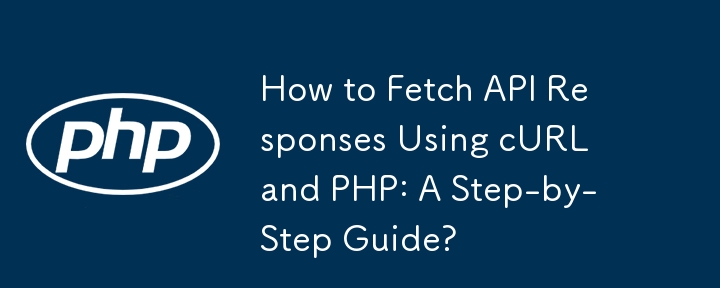
How to Fetch API Responses Using cURL and PHP: A Step-by-Step Guide?
Article Introduction:This article provides a code snippet for a PHP class that utilizes cURL to fetch API responses. The snippet defines a function to retrieve the API response, handle redirects, set user agent, and manage timeouts, making it a useful tool for interactin
2024-10-26
comment 0
1107

Using Eloquent API Resources in Laravel.
Article Introduction:EloquentAPIResources is a tool in Laravel for building structured JSON responses. 1. It serves as a conversion layer between the model and the output data; 2. It can control the return field, add additional fields, and unified format; 3. Create a Resource class through Artisan and define a toArray method; 4. Use newResource() or Resource::collection() to return data in the controller; 5. Usage techniques include avoiding deep nesting, preloading relationships, conditional return fields, custom paging and naming specifications. Rational use can improve the clarity and performance of the API.
2025-07-23
comment 0
965

How do you implement custom session handling in PHP?
Article Introduction:Implementing custom session processing in PHP can be done by implementing the SessionHandlerInterface interface. The specific steps include: 1) Creating a class that implements SessionHandlerInterface, such as CustomSessionHandler; 2) Rewriting methods in the interface (such as open, close, read, write, destroy, gc) to define the life cycle and storage method of session data; 3) Register a custom session processor in a PHP script and start the session. This allows data to be stored in media such as MySQL and Redis to improve performance, security and scalability.
2025-04-24
comment 0
736

Working with abstract base classes in Python
Article Introduction:Abstract base class (ABC) is a tool used in Python to define interfaces. It is implemented through the abc module and cannot be instantiated. It must be inherited by subclasses and implements its abstract methods. 1. Use abc.ABC and @abstractmethod to define abstract methods to ensure that subclasses implement specific interfaces; 2. Abstract base classes can contain specific methods for subclass inheritance; 3. Support multi-level inheritance to further refine abstract requirements; 4. Abstract properties can also be defined and subclasses can implement attributes. It helps improve code readability, avoid runtime errors, and is suitable for building clear structured projects.
2025-07-12
comment 0
501

Memory Performance Boosts with Generators and Nikic/Iter
Article Introduction:PHP iterator and generator: a powerful tool for efficient processing of large data sets
Arrays and iterations are the cornerstone of any application. As we get new tools, the way we use arrays should also improve.
For example, a generator is a new tool. At first we only have arrays, and then we gain the ability to define our own class array structure (called iterators). But since PHP 5.5, we can quickly create class iterator structures called generators.
Generators look like functions, but we can use them as iterators. They provide us with a simple syntax for creating essentially interruptible, repeatable functions. They are amazing!
We will look at several areas where generators can be used and explore the need to note when using generators
2025-02-16
comment 0
511

What is Reflection API in PHP and give practical examples?
Article Introduction:The Reflection API in PHP allows you to check and manipulate code at runtime. 1) It implements reflection function through classes such as ReflectionClass. 2) The working principle of the reflection API depends on the Zend engine. 3) The basic usage includes checking the class structure. 4) Advanced usage can implement dependency injection containers. 5) Common errors need to be handled through try-catch. 6) Performance optimization suggestions include cache reflection results and avoiding unnecessary reflections.
2025-04-04
comment 0
634

php get all dates between two dates
Article Introduction:To get all dates between two dates, it is not difficult to implement with PHP. Just pay attention to the time format and loop logic, and it can be easily done. Generate date list using the DateTime class PHP's built-in DateTime class is a good tool for handling dates. We can use it to iterate through every day between the start date and the end date. functiongetDatesBetween($start,$end){$dates=[];$current=newDateTime($start);$end=newDateTime($end);whi
2025-07-06
comment 0
413

Suggesting Carbon with Composer - Date and Time the Right Way
Article Introduction:Carbon: PHP date and time processing tool
Carbon is a lightweight PHP library for simplifying the processing of dates and times. It is based on and extends the core DateTime class and adds many convenient methods to make date-time operation easier. This article will introduce the basic usage of Carbon and demonstrate how to use it in a real project.
Core points:
Carbon is a library designed for PHP date and time operations, extends the core DateTime class and adds user-friendly methods to provide a more intuitive experience.
The library can be installed using Composer and can be instantiated from strings, timestamps, or other DateTime or Carbon instances
2025-02-16
comment 0
540
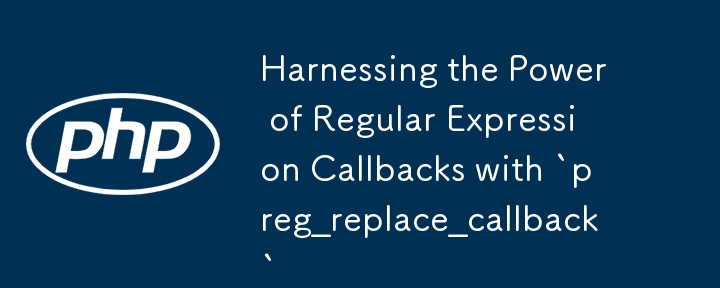
Harnessing the Power of Regular Expression Callbacks with `preg_replace_callback`
Article Introduction:preg_replace_callback is a powerful tool in PHP for dynamic string replacement, which implements complex logic by calling custom functions for each regular match. 1. The function syntax is preg_replace_callback($pattern,$callback,$subject), where $callback can dynamically process the matching content; 2. It can be used for numerical transformation, such as replacing [10] with [20]; 3. Supporting multi-capture group operations, such as converting the YYYY-MM-DD format date to "May15,2024"; 4. Combining the use keyword can maintain the status, such as adding an incremental number to each word; 5. Applicable to
2025-07-30
comment 0
739

Setting up Broadcasting with Laravel Echo?
Article Introduction:To set up broadcasts with LaravelEcho, first configure Pusher as the broadcast driver, then install and initialize the LaravelEcho and PusherJS libraries, then define broadcastable events in Laravel, then listen to these events on the front end, and finally pay attention to common problems. 1. Configure Pusher's credentials in the .env file and clear the configuration cache; 2. Install laravel-echo and pusher-js through npm and initialize Echo in the JS entry file; 3. Create an event class that implements the ShouldBroadcast interface and trigger events in the appropriate location; 4. Use Echo to listen for specified channels and events in the front-end; 5. Pay attention to the construction tool
2025-07-10
comment 0
966

Clean Code and PHP Comments
Article Introduction:Writing good code and annotations can improve project maintainability and professionalism. 1.CleanCode emphasizes clear naming, single responsibilities and structures, so that it is easy for others to understand; 2. Comments should explain "why" rather than duplicate code functions; 3. PHP comments should cover class descriptions, method parameters, and key logical backgrounds; 4. Practical suggestions include using meaningful variable names, unified annotation style, and using tool specifications.
2025-07-18
comment 0
910
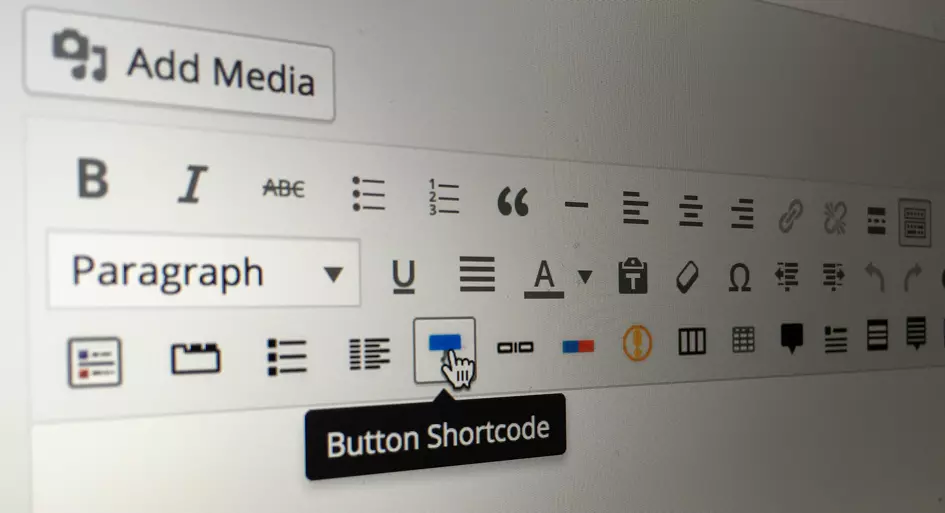
Custom Shortcodes for WordPress
Article Introduction:WordPress shortcode: a powerful tool to simplify website functionality
This article will explore WordPress shortcodes, a convenient and quick way to create dynamic and complex website features. Short code is like pseudo-code, which implements custom functions through function execution without the need to write complex PHP code.
Shortcode overview
WordPress shortcodes are an efficient mechanism that generate dynamic and powerful elements with just a small amount of input. Developers usually create website functions through PHP code, but for non-developer users, it is not friendly to operate PHP code directly. Short code solves this problem perfectly, allowing users to create powerful website features using pseudo-code similar to macros. After the short code is called, the parameters will be received (
2025-02-18
comment 0
963

What are interfaces in PHP?
Article Introduction:Interfaces are used in PHP to define contracts that classes must follow, specifying methods that classes must implement, but do not provide specific implementations. This ensures consistency between different classes and facilitates modular, loosely coupled code. 1. The interface is similar to a blueprint, which specifies what methods should be used for a class but does not involve internal logic. 2. The class that implements the interface must contain all methods in the interface, otherwise an error will be reported. 3. Interfaces facilitate structural consistency, decoupling, testability and team collaboration across unrelated classes. 4. Using an interface is divided into two steps: first define it and then implement it in the class. 5. Classes can implement multiple interfaces at the same time. 6. The interface can have constants but not attributes. PHP7.4 supports type attributes but is not declared in the interface. PHP8.0 supports named parameters to improve readability.
2025-06-23
comment 0
331

How do I develop my own Composer plugin?
Article Introduction:To start building a custom Composer plugin, first understand its basic structure and how it works. 1. Understand the basics of Composer plug-in: Plugin is a PHP package that implements Composer\Plugin\PluginInterface, which can hook internal events of Composer; key components include plug-in classes, event listeners and commands. 2. Set the plug-in structure: Create a project containing the src directory and composer.json, define PSR-4 automatic loading and specify the plug-in class. 3. Hook events or add commands: register event listeners through the activate() method or implement CommandProviderInterface to introduce CLI commands
2025-07-22
comment 0
926
